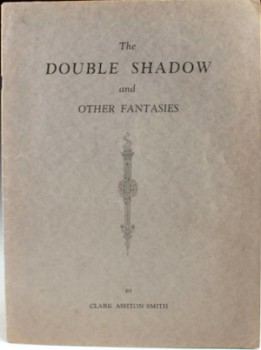Birthday Reviews: Clark Ashton Smith’s “The Maze of Maal Dweb”

Clark Ashton Smith was born on January 13, 1893 and died on August 14, 1961. Along with H.P. Lovecraft, he was one of the major authors at Weird Tales, writing stories which were similar to the dark fantasies Lovecraft wrote.
Smith maintained a correspondence with Lovecraft for the last 15 years of Lovecraft’s life. While Lovecraft wrote about Cthulhu, Smith wrote about the far future Zothique. Smith was named the Cordwainer Smith Rediscovery Award winner in 2015.
“The Maze of Maal Dweb” first appeared in a limited edition chapbook, The Double Shadow and Other Fantasies, published by Smith in 1933. A the time the story was called “The Maze of the Enchanter.” It received its first general publication, and under its better known title, in the October 1938 issue of Weird Tales, edited by Farnsworth Wright.
Smith included it in his 1944 collection Lost Worlds and it has frequently been reprinted since, including translations into Dutch, German, French, and Italian. Maal Dweb also appeared in Smith’s story “The Flower-Women.”
“The Maze of Maal Dweb” has Tiglari working his way through a swamp to retrieve his beloved, Athlé, from the titular lord of the solar system. Despite Maal Dweb’s palace being impregnable, Tiglari has somehow managed to acquire knowledge of the dangers that lie within, so he can arm himself appropriately for his quest.
Similarly unexamined is how Maal Dweb, a recluse who is never seen by anyone except the women he orders sent to him, can successfully rule his vast domains. Similarly, the palace is seemingly unpopulated except by the petrified forms of Maal Dweb’s previous victims. Rather than a living home in which to live, Maal Dweb sits like bait in his trap, waiting for doomed adventurers to come to him.
While Tiglari explores the strange fortress and gardens that surround it, to a modern reader the story feels like a poorly planned gaming scenario, where the antagonist has nothing better to do but set up traps and wait for the protagonist to spring them.
Reprint reviewed in the collection Lost Worlds, Bison, 2006.
 Steven H Silver is a fifteen-time Hugo Award nominee and was the publisher of the Hugo-nominated fanzine Argentus as well as the editor and publisher of ISFiC Press for 8 years. He has also edited books for DAW and NESFA Press. He began publishing short fiction in 2008 and his most recently published story is “Big White Men—Attack!” in Little Green Men—Attack! Steven has chaired the first Midwest Construction, Windycon three times, and the SFWA Nebula Conference 5 times as well as serving as the Event Coordinator for SFWA. He was programming chair for Chicon 2000 and Vice Chair of Chicon 7. He has been the news editor for SF Site since 2002.
Steven H Silver is a fifteen-time Hugo Award nominee and was the publisher of the Hugo-nominated fanzine Argentus as well as the editor and publisher of ISFiC Press for 8 years. He has also edited books for DAW and NESFA Press. He began publishing short fiction in 2008 and his most recently published story is “Big White Men—Attack!” in Little Green Men—Attack! Steven has chaired the first Midwest Construction, Windycon three times, and the SFWA Nebula Conference 5 times as well as serving as the Event Coordinator for SFWA. He was programming chair for Chicon 2000 and Vice Chair of Chicon 7. He has been the news editor for SF Site since 2002.
[…] (8) NATAL DAY. Steven H Silver continues his Black Gate series — “Birthday Reviews: Clark Ashton Smith’s “The Maze of Maal Dweb”. […]
I guess it all depends on what you mean by a living home! Maal Dwebb is very much a CAS/Jack Vance trope, the solitary sorcerer in his lair whose mastery of the dark arts has rendered him pretty near omnipotent, but also bored and cruel, and the story is – like pretty much everything CAS wrote – an exercise in style rather than plot, and none the worse for that. I have to admit to being biased, as it was the first CAS story I read and my favourite, with ‘The Empire of the Necromancers’ coming a close second.
There is another story featuring Maal Dwebb – http://www.eldritchdark.com/writings/short-stories/73/the-flower-women – where we get a glimpse into the extent of his powers and his working day, such as it is.
Leaving “The Flower Women” aside, I can’t see Maal Dweb, as depicted in “The Maze of Maal Dweb” actually doing anything aside from waiting for some idiot to infiltrate his house so he can wreak vengeance on him. Perhaps “The Web of Maal Dweb” would have been a more accurate title since Maal Dweb seems to be waiting, spider-like, for his prey.
Clark Ashton Smith was a genius of a level above HPL and even Robert E Howard. Almost as good as Lord Dunsany.
The thing was, he wasn’t a formulaic storytelling artist. He was a poet who also wrote stories. And the stories were meant to express things, the main ‘character’ was the setting. I’m glad other commenters seem to realize this.
It’s funny coz HPL managed to meet Lord Dunsany and probably wrote him several thousand letters… I think Lord Dunsany reacted kind of like Mark Hamill in “Just Shoot Me” where he went – “Wait a second… You are the guy who appeared on my last tour… At EVERY Star Wars convention, from New York to San Fransisco…?” HPL’s “Dream Quest of Unknown Kadath” is blatant “Sincerest form of flattery” though his dark vision frees it from any plagarism by far.
Somehow, I wish CAS could have met Lord Dunsany…